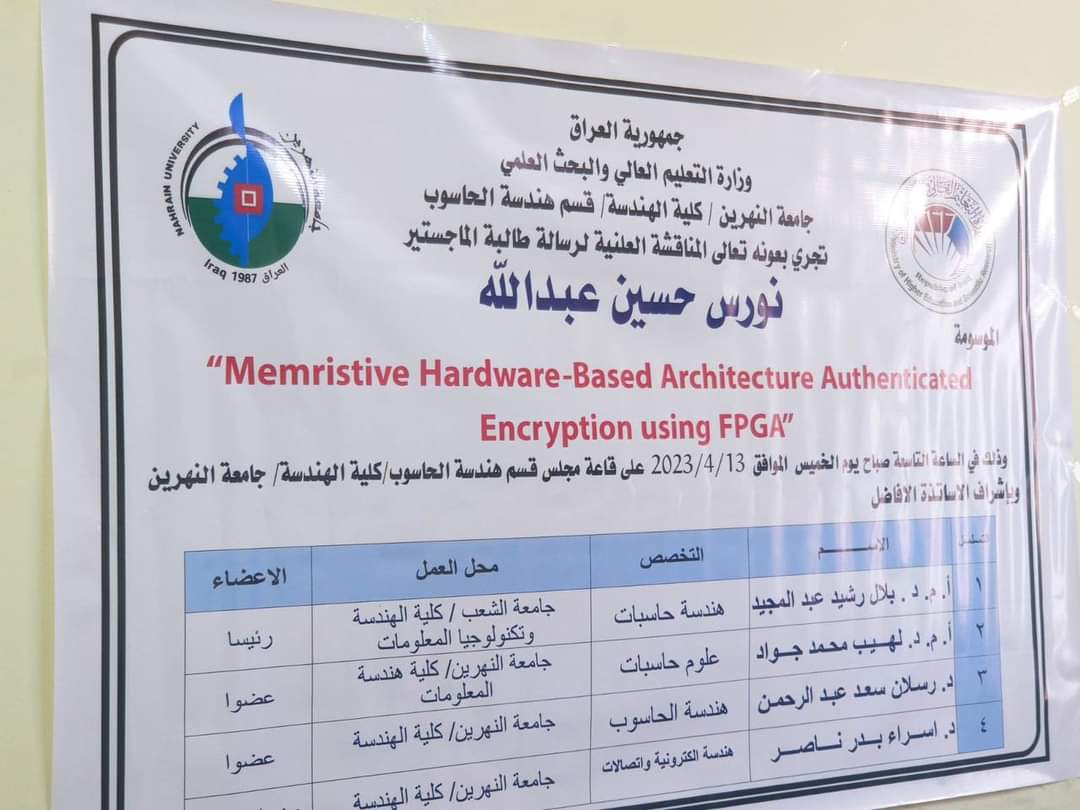Visitors: 33393776 Views
Done By: Department of Computer Engineering
Post Date: 2023-04-16
Last Browse: 2025-12-15

jarat munaqashat talibat almajistir (nuras husayn eabdallah) min qism handasat alhasub ean risalatiha almawsumati: "Memristive Hardware-Based Architecture Authenticated Encryption Using FPGA" wadhalik ealaa qaeat majlis qism handasat alhasub min yawm alahid almasadif 16/4/2023 wata'alafat lajnat almunaqashat min alsaadat almudrajat 'asmawuhum 'adnahi: 'a.mu.da. bilal rashid eabdalmijid/jamieat alshaebu/kiliat alhandasat watiknulujia almelwmat.ryysaan 'u.mu.da. lahib muhamad jawadi/ jamieat alnahrini/kiliat handasat almelwmat.edwaan mu.da. raslan saed eabdalrahmin/jameat alnahrayn /kaliyat alhnds.edwaan mu.du. asara' badr nasir/jamieat alnahrayn /kuliyat alhnds.mshrfa alaihdafi: tatadaman aihdaf albahth ainsha' miemariat altashfir almusadiq lilajihazat alqayimat ealaa tiqniat almimristur nanutiknuluji bi'ustikhdam albawaabat almantiqiat alqabilat lilbarmaja waqad listufit altaalibat mutatalabat alhusul ealaa shahadat almajistir binajah Internet
of Things
(IoT) connects various devices through the network such as smart devices, radio
frequency identification tags, and sensors. Sharing sensitive information and
private data between these devices needs to provide a secure communication path
and safe access. Most of these devices have limited resources including memory,
size, speed, and power, which will require ultra-low power consumption devices
and lightweight cryptographic algorithms. Memristor, a novel nanotechnology
device is embedded in hardware security applications because of its unique electrical
response. Memristor’s electrical response displays a hysteresis loop that is
pinched in the current-voltage (I-V) plane. As a result, a specific
mathematical model finds it challenging to forecast the behavior of individual
memristor devices. This
work presents a new hardware security module (HSM) involving memristive key
generation relays mainly on the unique behavior of the memristor's I-V
characteristics. The generated memristor-based secret key has been utilized in
the hardware implementation of a lightweight authenticated encryption scheme,
which is based on the ANU-II block cipher algorithm and PHOTON hash function.
The latency is equal to 16, 13, and 36 clock cycles for the memristive key
generation, ANU-II block cipher, and PHOTON hash function, respectively. Two
authenticated encryption data path approaches were implemented: Encrypt-then-Mac
(EtM) and Mac-then-Encrypt (MtE). The latency of the EtM is a 65-clock cycle,
while the latency of the MtE is 123 clock cycles.
The
proposed design shows high throughput and efficiency. A throughput of 533.089,
482.796, 643.771, 702.068, 226.036, and 323.143 Mbps and efficiency of 0.6959,
0.6696, 0.8929, 0.9737, 0.3018, and 0.4445 Mbps/slice have been obtained when implementing
the proposed design on Virtex-4, Virtex-5, Virtex-6, Virtex-7, Spartan-3 and
Spartan-6, respectively. Also, the proposed work achieved low power consumption
equal to 1618, 3542, 3447, 177, 338, and 117 mW when implemented on Virtex-4,
Virtex-5, Virtex-6, Virtex-7 Spartan-3, and Spartan-6 FPGA platforms,
respectively. Where lower power consumption is achieved on both Spartan-6 and
Virtex-7 platforms.